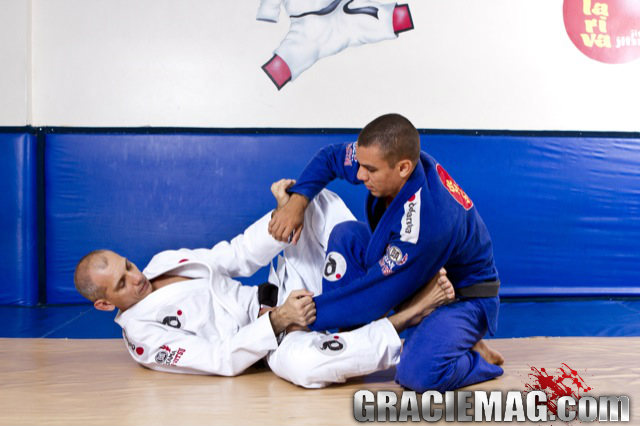
Ricardo de la Riva and his guard. Gustavo Aragão/GRACIEMAG
[ Willian von Söhsten * ]
I often kid with my studens that there are so many moves in BJJ that I could cover pages and pages of a notebook with just their names. Some names are Japanese; others, American; and others, Brazilian.
But there are moves with more interesting histories — a connection with fighters that, one way or another, left a good impression in the Gracie dynasty and their followers.
The first one is the famous kimura lock. Originally known as ude garami, it was immediately re-baptized in Brazil by the Gracie family after the epic bout between Helio Gracie and Masahiko Kimura. The Japanese judoka from the Kodokan School was a phenomenon in his art — the youngest godan (fifth-degree black-belt) in judo history.
Known worldwide in a time before the Internet, in 1951 he came to Brazil to confront the thin, fearless Helio Gracie. There was a considerable difference in size, weight and age between the two, and, even so, the Brazilian resisted the “Japanese giant” for 13 minutes before falling prey to the efficient shoulder lock.
Thenceforth the move became known in BJJ schools as the kimura — an allusion to one of few fighters who managed to beat Gracie. (See the technique next.)
The second move we look at here was also named after a judoka, but a Brazilian one. If during a competition your coach tells you to attempt a sode guruma jime, you will probably be stumped. But that’s just the Japanese name of the choke we call the ezequiel.
Ezequiel Paraguassu is a great Brazilian judoka who took part in the Seoul-88 and Barcelona-92 Olympics. Before he made the trip to South Korea, he decided to hone his ground techniques, which is why he sought the school led by Grandmaster Carlson Gracie.
Bucking one of the big premises of BJJ, which says the top fighter must get past his foe’s guard to achieve a submission, Ezequiel racked up many victims in training by using the sode guruma jime from inside their guards.
In judo, the move didn’t gain much popularity, since the time restriction for ground action inhibits its application somewhat. In BJJ, without that problem, the technique gained traction and was widely disseminated. What’s curious is that, following his Olympic showings, Ezequiel moved to Switzerland, where he lived having no clue that his name was associated to the move in BJJ gyms all over Brazil.
Some 19 years later he heard, from another teacher, the instruction for a student to tighten up an ezequiel. (Can you lock Mr. Paraguassu’s move in place? Find out below.)
Finally, the famous de la Riva guard is one of the big milestones of modern BJJ. Instinctively perfected by Ricardo de la Riva, it accrued more fame after being used against Royler Gracie, who was at that point undefeated as a featherweight, during the 1986 Cantão Cup. Like the other positions mentioned here, this style of guard had already proven strong in judo — in the nonatei style, to be precise.
And so Kimura, Ezequiel and de la Riva are names that carry a bit of BJJ history. Do you like using any of those while sparring? Wrap up by going over the de la Riva, and good training!
* Willian von Söhsten is a black-belt under Cícero Costha and a BJJ teacher at Team Nogueira in Ribeirão Preto, Brazil.
The post Ezequiel, Kimura, De la Riva… Study the BJJ moves named after people first appeared on Graciemag.